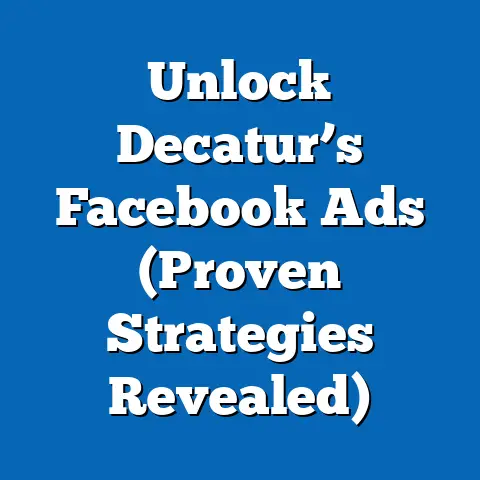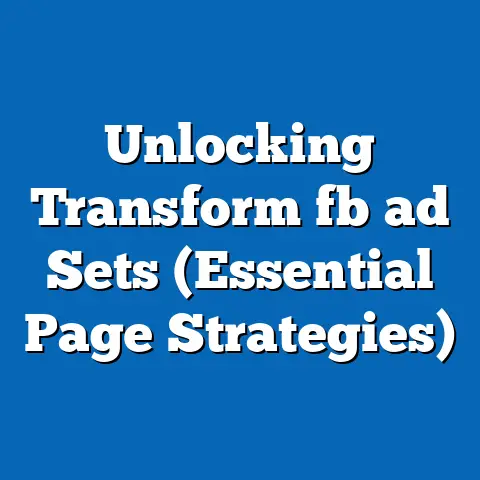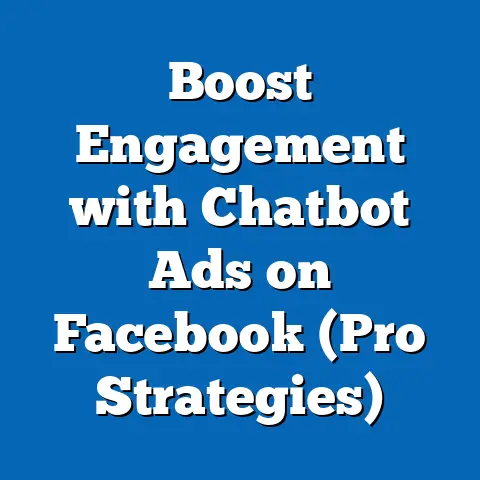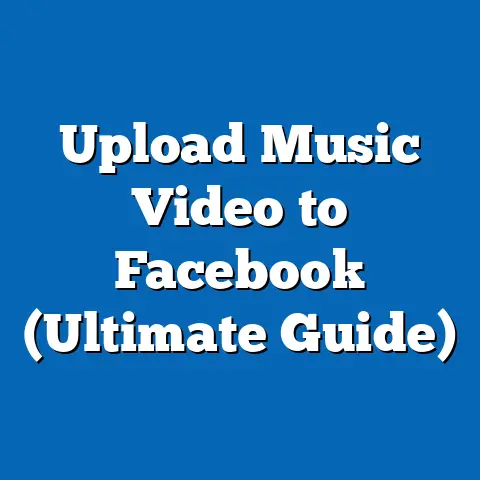Boost Q4 ROI with Smart Facebook Ads (Expert Strategies)
The air is getting crisper, the leaves are changing color, and businesses everywhere are gearing up for the most crucial time of the year: Q4. It’s no secret that the fourth quarter is the golden goose for many companies, with holiday shopping sprees driving a significant portion of annual revenue. But here’s the thing: everyone else knows this too. That means the competition for consumer attention – and their wallets – is fiercer than ever.
I’ve seen firsthand how a well-executed Facebook ad strategy can be the difference between a record-breaking quarter and a disappointing one. I remember working with a small e-commerce business a few years back. They had a fantastic product, but their Q3 sales were lackluster. With Q4 looming, they were nervous. We revamped their Facebook ad strategy, focusing on hyper-targeted audiences, compelling holiday-themed visuals, and irresistible offers. The result? A 300% increase in sales compared to the previous quarter. It was a game-changer for them.
The beauty of Facebook advertising lies in its flexibility. You don’t need months to overhaul your marketing plan. With Facebook Ads Manager, you can quickly adapt your campaigns, test new strategies, and capitalize on the seasonal surge in online shopping. But speed isn’t enough. You need to be smart, strategic, and data-driven.
That’s where this guide comes in. I’m going to walk you through expert strategies for enhancing your Facebook ad performance to significantly boost your ROI in Q4. We’ll cover everything from understanding the unique Q4 landscape to crafting compelling ads, targeting the right audience, optimizing your budget, and leveraging Facebook’s most powerful features. Let’s dive in and make this your best Q4 yet!
Understanding the Q4 Landscape
Q4 isn’t just another quarter; it’s a different beast altogether. To truly maximize your ROI, you need to understand the specific trends and challenges that define this period.
Seasonal Trends
Consumer behavior undergoes a dramatic shift in Q4. It’s a time of heightened emotions, increased spending, and a focus on gifting and celebration. To understand these trends, let’s break them down:
- Spending Patterns: People are simply more willing to open their wallets in Q4. According to the National Retail Federation, holiday sales in 2023 reached over $960 billion. This surge is driven by a combination of factors, including holiday bonuses, pent-up demand, and the desire to spread joy through gifting.
- Key Shopping Dates: Q4 is punctuated by several critical shopping dates that demand targeted strategies.
- Black Friday and Cyber Monday: These are the undisputed kings of the Q4 shopping season. Black Friday, traditionally a brick-and-mortar event, has increasingly moved online, while Cyber Monday remains a purely digital phenomenon. Consumers expect deep discounts and limited-time offers on these days.
- Green Monday: Often overlooked, Green Monday (the second Monday in December) can be a significant sales day, especially for online retailers. It’s often the last day to order items with standard shipping for Christmas delivery.
- Christmas and Boxing Day: As Christmas approaches, the focus shifts to last-minute gift purchases and experiences. Boxing Day (December 26th) is traditionally a day for clearance sales and post-holiday deals.
- Economic Factors: The overall economic climate plays a crucial role in shaping consumer spending habits. Factors like inflation, interest rates, and employment rates can influence how much people are willing to spend. For example, if inflation is high, consumers may be more price-sensitive and seek out discounts and deals.
- Black Friday and Cyber Monday: These are the undisputed kings of the Q4 shopping season. Black Friday, traditionally a brick-and-mortar event, has increasingly moved online, while Cyber Monday remains a purely digital phenomenon. Consumers expect deep discounts and limited-time offers on these days.
- Green Monday: Often overlooked, Green Monday (the second Monday in December) can be a significant sales day, especially for online retailers. It’s often the last day to order items with standard shipping for Christmas delivery.
- Christmas and Boxing Day: As Christmas approaches, the focus shifts to last-minute gift purchases and experiences. Boxing Day (December 26th) is traditionally a day for clearance sales and post-holiday deals.
Takeaway: Understanding these seasonal trends is the foundation of a successful Q4 Facebook ad strategy. Tailor your messaging, offers, and timing to align with these patterns.
Competitive Analysis
The increased consumer demand in Q4 also means heightened competition among businesses. Everyone is vying for the same eyeballs, which can significantly impact your ad costs and strategies.
- Increased Ad Costs: With more businesses bidding on the same keywords and targeting the same audiences, ad costs inevitably rise. Cost-per-click (CPC) and cost-per-thousand impressions (CPM) can skyrocket during this period. I’ve seen CPCs double or even triple in some niches during the peak of the holiday season.
- Strategy Adjustments: To combat increased competition, you need to be more strategic with your ad campaigns. This means refining your targeting, optimizing your ad creative, and carefully managing your budget. It’s not enough to simply run the same ads you’ve been using all year. You need to adapt and innovate to stand out from the crowd.
- Standing Out from the Crowd: In a sea of holiday ads, your ads need to be attention-grabbing and memorable. This requires a deep understanding of your target audience and the ability to craft compelling messaging that resonates with their needs and desires.
Takeaway: Be prepared for increased competition and higher ad costs in Q4. Refine your targeting, optimize your ad creative, and carefully manage your budget to stay ahead of the curve.
Target Audience Insights
Understanding how your target audience’s behavior shifts in Q4 is crucial for tailoring your messaging and offers.
- Shifting Priorities: During the holidays, people are often focused on gift-giving, spending time with loved ones, and celebrating traditions. Your messaging should reflect these priorities.
- Emotional Connection: Tap into the emotional aspect of the holidays. Use imagery and language that evokes feelings of warmth, joy, and nostalgia.
- Personalization: Personalize your ads based on audience demographics, interests, and past behavior. Use dynamic product ads to showcase products that your audience has previously viewed or purchased.
Takeaway: Tailor your messaging to align with holiday sentiments and tap into the emotional aspect of the season. Personalize your ads based on audience demographics, interests, and past behavior.
Crafting Effective Facebook Ads
Now that we understand the Q4 landscape, let’s dive into the specifics of creating Facebook ads that capture attention and drive conversions.
Ad Formats and Their Advantages
Facebook offers a variety of ad formats, each with its own strengths and weaknesses. Choosing the right format can significantly impact your ad performance during Q4.
- Carousel Ads: Carousel ads allow you to showcase multiple products or features in a single ad. This format is particularly effective for e-commerce businesses looking to promote a range of holiday gifts.
- Advantage: High engagement rates, ability to showcase multiple products, increased click-through rates.
- Example: An apparel retailer can use a carousel ad to showcase different holiday outfits, each with a link to the product page.
- Video Ads: Video ads are highly engaging and can be used to tell a story, showcase a product in action, or share a customer testimonial.
- Advantage: Captures attention, conveys complex information, builds brand awareness.
- Example: A toy company can create a video ad showcasing children playing with their toys during the holidays, evoking feelings of joy and nostalgia.
- Collection Ads: Collection ads are designed for mobile shoppers and allow you to showcase a catalog of products in a visually appealing format.
- Advantage: Mobile-friendly, visually appealing, drives product discovery.
- Example: A home goods retailer can use a collection ad to showcase their holiday decor collection, allowing users to browse and purchase products directly from the ad.
- Image Ads: Simple but effective, image ads can be used to promote a single product or offer.
- Advantage: Easy to create, cost-effective, can be highly targeted.
- Example: A local restaurant can use an image ad to promote their holiday menu, showcasing a mouth-watering photo of their signature dish.
- Advantage: High engagement rates, ability to showcase multiple products, increased click-through rates.
- Example: An apparel retailer can use a carousel ad to showcase different holiday outfits, each with a link to the product page.
- Advantage: Captures attention, conveys complex information, builds brand awareness.
- Example: A toy company can create a video ad showcasing children playing with their toys during the holidays, evoking feelings of joy and nostalgia.
- Advantage: Mobile-friendly, visually appealing, drives product discovery.
- Example: A home goods retailer can use a collection ad to showcase their holiday decor collection, allowing users to browse and purchase products directly from the ad.
- Advantage: Easy to create, cost-effective, can be highly targeted.
- Example: A local restaurant can use an image ad to promote their holiday menu, showcasing a mouth-watering photo of their signature dish.
Takeaway: Experiment with different ad formats to see what works best for your business and target audience. Consider using carousel, video, and collection ads to showcase multiple products or features.
Compelling Visuals and Copy
In the crowded Q4 advertising landscape, your ads need to be visually appealing and persuasive to capture attention and drive conversions.
- Eye-Catching Visuals: Use high-quality images and videos that are relevant to the holiday season. Consider using festive colors, holiday-themed imagery, and images of people celebrating.
- Persuasive Ad Copy: Craft ad copy that is clear, concise, and compelling. Highlight the benefits of your product or service and create a sense of urgency.
- Examples of Successful Ads:
- Airbnb: Their holiday ads often feature cozy cabins and snow-covered landscapes, evoking feelings of warmth and relaxation.
- Coca-Cola: Their iconic holiday ads, featuring Santa Claus and the polar bears, are instantly recognizable and create a sense of nostalgia.
- Amazon: Their holiday ads often showcase a variety of products, highlighting the convenience and affordability of shopping on Amazon.
- Airbnb: Their holiday ads often feature cozy cabins and snow-covered landscapes, evoking feelings of warmth and relaxation.
- Coca-Cola: Their iconic holiday ads, featuring Santa Claus and the polar bears, are instantly recognizable and create a sense of nostalgia.
- Amazon: Their holiday ads often showcase a variety of products, highlighting the convenience and affordability of shopping on Amazon.
Takeaway: Use high-quality visuals and persuasive ad copy that resonates with the holiday spirit. Study successful ads from other brands to gain inspiration.
Call-to-Action Strategies
A strong call-to-action (CTA) is essential for driving conversions. Your CTA should be clear, concise, and tell users exactly what you want them to do.
- Strong CTAs: Use action-oriented verbs like “Shop Now,” “Learn More,” “Get Started,” and “Download.”
- Q4-Tailored CTAs: Tailor your CTAs to Q4 promotions. Examples include “Shop Holiday Deals,” “Give the Gift of,” “Limited-Time Offer,” and “Get it Before Christmas.”
- Sense of Urgency: Create a sense of urgency by using phrases like “Limited Quantities Available,” “Offer Ends Soon,” and “Order Now to Guarantee Delivery.”
Takeaway: Use strong CTAs that are tailored to Q4 promotions and create a sense of urgency. Make it easy for users to take the next step.
Targeting the Right Audience
Even the most beautifully crafted ad will fall flat if it’s shown to the wrong people. Effective targeting is the key to maximizing your ROI on Facebook.
Custom Audiences
Custom Audiences allow you to target specific groups of people based on their past interactions with your business. This is a powerful way to re-engage past customers and website visitors.
- Re-engaging Past Customers: Upload your customer list to Facebook and create a Custom Audience to target these individuals with special offers and promotions. This is a great way to reward loyal customers and drive repeat purchases.
- Website Visitors: Use the Facebook Pixel to track website visitors and create a Custom Audience of people who have visited specific pages or taken certain actions on your website. This allows you to retarget these individuals with ads that are relevant to their interests.
- Video Viewers: Create a Custom Audience of people who have watched your video ads. This is a great way to target individuals who have already shown an interest in your brand or product.
Takeaway: Leverage Custom Audiences to re-engage past customers, website visitors, and video viewers. This is a highly effective way to drive conversions and increase ROI.
Lookalike Audiences
Lookalike Audiences allow you to expand your reach by targeting people who are similar to your existing customers. This is a great way to find new customers who are likely to be interested in your products or services.
- Based on High-Value Customers: Create a Lookalike Audience based on your high-value customers. This will help you target people who are most likely to make a purchase.
- Expand Reach Effectively: Use Lookalike Audiences to expand your reach beyond your existing customer base. This is a great way to find new customers who are similar to your best customers.
- Refine Audience Segmentation: Continuously refine your audience segmentation based on performance data. This will help you improve the accuracy of your Lookalike Audiences and increase your ROI.
Takeaway: Use Lookalike Audiences to expand your reach and target people who are similar to your existing customers. Continuously refine your audience segmentation based on performance data.
Advanced Targeting Techniques
Beyond Custom and Lookalike Audiences, Facebook offers a range of advanced targeting techniques that can help you reach your ideal customer.
- Interest-Based Targeting: Target people based on their interests, hobbies, and passions. This is a great way to reach people who are likely to be interested in your products or services.
- Behavioral Targeting: Target people based on their online behavior, such as their purchase history, device usage, and travel habits. This allows you to reach people who are likely to be in the market for your products or services.
- Facebook Insights: Use Facebook Insights to gain a deeper understanding of your audience’s demographics, interests, and behaviors. This information can help you refine your targeting and create more effective ad campaigns.
Takeaway: Use interest-based and behavioral targeting to reach people who are likely to be interested in your products or services. Leverage Facebook Insights to gain a deeper understanding of your audience.
Budgeting and Bidding Strategies
Setting the right budget and choosing the right bidding strategy are crucial for maximizing your ROI on Facebook.
Setting Your Budget
- Allocate Ad Spend Effectively: Determine how much you can afford to spend on Facebook ads during Q4. Consider your overall marketing budget and the potential ROI of your campaigns.
- Daily vs. Lifetime Budgets: Choose between daily and lifetime budgets based on your campaign goals and timeline. Daily budgets are ideal for ongoing campaigns, while lifetime budgets are better for campaigns with a specific end date.
- Starting Small and Scaling Up: Start with a smaller budget and gradually increase it as you see positive results. This allows you to test different strategies and optimize your campaigns without risking too much money.
Takeaway: Allocate your ad spend effectively, choose the right budget type, and start small before scaling up.
Bidding Strategies
- Cost-per-Click (CPC): Pay each time someone clicks on your ad. This strategy is ideal for driving traffic to your website.
- Cost-per-Action (CPA): Pay each time someone takes a specific action, such as making a purchase or filling out a form. This strategy is ideal for driving conversions.
- Cost-per-Thousand Impressions (CPM): Pay for every 1,000 times your ad is shown. This strategy is ideal for building brand awareness.
- Selecting the Right Strategy: Choose the bidding strategy that aligns with your campaign goals. If you’re focused on driving traffic, CPC is a good choice. If you’re focused on driving conversions, CPA is a better option.
Takeaway: Choose the bidding strategy that aligns with your campaign goals. Consider testing different strategies to see what works best for your business.
Monitoring and Adjusting Budgets
- Real-Time Monitoring: Monitor your campaign performance in real-time. Track key metrics like click-through rates, conversion rates, and cost-per-acquisition.
- Adjusting Budgets Based on Performance: Adjust your budget based on performance data. If a campaign is performing well, consider increasing the budget to reach more people. If a campaign is underperforming, consider decreasing the budget or pausing the campaign altogether.
- Don’t Set It and Forget It: Facebook advertising isn’t a “set it and forget it” activity. It requires ongoing monitoring and optimization.
Takeaway: Monitor your campaign performance in real-time and adjust your budget based on performance data. Facebook advertising requires ongoing monitoring and optimization.
Creative Testing and Optimization
The key to long-term success with Facebook advertising is continuous testing and optimization. You need to constantly experiment with different elements of your ads to identify what works best for your audience.
A/B Testing
- Testing Various Elements: A/B testing involves creating two versions of an ad with a single element changed. This allows you to isolate the impact of that element on your ad performance.
- Images, Copy, and CTAs: Test different images, ad copy, and calls-to-action to see what resonates best with your audience.
- Tools for A/B Testing: Use Facebook’s built-in A/B testing tool to easily create and manage your tests.
Takeaway: Use A/B testing to identify which images, ad copy, and calls-to-action resonate best with your audience.
Analyzing Performance Metrics
- Key Performance Indicators (KPIs): Track key performance indicators (KPIs) to measure the success of your campaigns.
- Click-Through Rates (CTR): CTR measures the percentage of people who click on your ad after seeing it. A high CTR indicates that your ad is relevant and engaging.
- Conversion Rates: Conversion rates measure the percentage of people who take a desired action after clicking on your ad, such as making a purchase or filling out a form.
- Return on Ad Spend (ROAS): ROAS measures the amount of revenue you generate for every dollar you spend on advertising. A high ROAS indicates that your campaigns are profitable.
Takeaway: Track key performance indicators (KPIs) like click-through rates, conversion rates, and return on ad spend to measure the success of your campaigns.
Iterating on Success
- Take Learnings from Tests: Analyze the results of your A/B tests and identify which elements performed best.
- Optimize Campaigns Continuously: Use your learnings to optimize your campaigns continuously for better results. This may involve changing your images, ad copy, targeting, or bidding strategy.
- Never Stop Testing: The Facebook advertising landscape is constantly evolving, so it’s important to never stop testing and optimizing your campaigns.
Takeaway: Take learnings from your A/B tests and optimize your campaigns continuously for better results. Never stop testing and optimizing your campaigns.
Leveraging Facebook’s Advanced Features
Facebook offers a range of advanced features that can help you take your advertising to the next level.
Dynamic Ads
- Retargeting and Upselling: Dynamic ads allow you to retarget users with products they have previously viewed on your website or app. You can also use dynamic ads to upsell or cross-sell products based on their past purchases.
- Personalized Product Recommendations: Dynamic ads personalize the products that are shown to each user based on their browsing history and purchase behavior.
- Increased Conversions: Dynamic ads can significantly increase your conversion rates by showing users products that they are already interested in.
Takeaway: Use dynamic ads for retargeting and upselling products effectively. Personalize the product recommendations that are shown to each user.
Facebook Shops and Checkout Features
- Streamlining the Shopping Experience: Facebook Shops allows you to create a storefront directly on Facebook, making it easy for users to browse and purchase your products without leaving the platform.
- Boosting Conversions: By streamlining the shopping experience, Facebook Shops can significantly boost your conversion rates.
- Mobile-First Approach: Facebook Shops is designed with a mobile-first approach, making it easy for users to shop on their smartphones.
Takeaway: Integrate Facebook Shops to streamline the shopping experience and boost conversions.
Utilizing Facebook Pixel
- Tracking User Behavior: The Facebook Pixel is a snippet of code that you place on your website to track user behavior.
- Optimizing Ad Campaigns: The Facebook Pixel allows you to track conversions, optimize your ad campaigns, and build custom audiences.
- Essential for Success: The Facebook Pixel is essential for any business that wants to succeed with Facebook advertising.
Takeaway: Utilize the Facebook Pixel to track user behavior and optimize your ad campaigns.
Conclusion
We’ve covered a lot of ground, from understanding the unique Q4 landscape to leveraging Facebook’s advanced features. Let’s recap the key strategies to keep in mind as you prepare your Facebook ad campaigns for the holiday season:
- Understand the Q4 Landscape: Recognize the seasonal trends, competitive environment, and shifting audience priorities.
- Craft Effective Ads: Use compelling visuals and persuasive ad copy that resonate with the holiday spirit. Experiment with different ad formats and use strong calls-to-action.
- Target the Right Audience: Leverage Custom Audiences and Lookalike Audiences to reach your ideal customer.
- Optimize Your Budget: Allocate your ad spend effectively, choose the right bidding strategy, and monitor your campaign performance in real-time.
- Test and Optimize: Continuously test different elements of your ads and optimize your campaigns based on performance data.
- Leverage Advanced Features: Utilize dynamic ads, Facebook Shops, and the Facebook Pixel to take your advertising to the next level.
Q4 presents a tremendous opportunity to boost your ROI and achieve your business goals. By implementing these smart Facebook ad strategies, you can capitalize on the seasonal surge in online shopping and drive significant results.
Don’t wait! Take action today. Start implementing these strategies now to maximize your Q4 ROI. The holiday season is fast approaching, and the time to prepare is now. Embrace the opportunities Q4 presents and leverage the power of Facebook advertising to achieve your business goals. I’m confident that with these strategies in place, you’ll see a significant boost in your ROI and have a truly successful Q4. Now go out there and make it happen!





